Download a pdf version of the poster here
Dr. Aaron Van Vliet is no longer a practicing physician at the North Bay Regional Health Centre. With this change, comes the need to reschedule some orthopedic patients.
We understand the disruption these changes are having on our patients and their families, and also appreciate the frustration many are feeling.
Please note that patients with referrals that were sent directly to Dr. Van Vliet’s office who have not yet been contacted for an appointment at the North East Joint Assessment Centre (NEJAC) should contact their primary care provider for a new referral.
All other patients will be contacted as follows:
Patients scheduled for surgeries: the Hospital will be contacting these patients to offer a choice of alternate surgeons to perform the surgery;
NEJAC patients: patients already assessed by NEJAC will be contacted by NEJAC staff and offered a choice of alternate surgeons to perform the surgery.
Thank you for your support and patience as we work as quickly as we can to contact all those impacted. Should you require additional information, please contact the office of the Chief Nursing Executive and Vice President, Clinical, Joanne Laplante.
The holidays can be one of the busiest time for emergency departments. Increases in respiratory illnesses like influenza and gastro bugs; slips and falls; and reduced hours for other health care services can contribute to longer wait times in the ED.
Hospitals are a 24/7 operation and are often the back up when other health care options are not available.
To help avoid non-urgent visits to the ED, consider refilling medications, scheduling any needed medical appointments, and making sure all medical equipment (such as inhalers, respirators) are in good working order. Check out the holiday availability of walk-in clinics for our area, or connect with a registered nurse day or night for free, secure and confidential health advice by calling all 811 (TTY: 1-866-797-0007) or chatting online. Take time to find supports and put your mental health first.
If you do need to come to the Emergency Department over the holidays, here are some things you can do to have a more comfortable wait:
Our team works to prioritize patients needing emergency medical care and the sickest—or most emergent—patients are seen first. Patients who come in with an issue that is not urgent will be triaged accordingly.
We are grateful to our dedicated healthcare workers and administrative staff for your continued care for our community and wish everyone a safe and happy holiday. We thank you for your continued understanding, patience and kindness.
Today, the North Bay Regional Health Centre (NBRHC) issued an emergency department (ED) wait time alert for July and August. The Health Centre continues to see higher than average patient volumes, combined with ongoing health human resource and capacity pressures, resulting in longer wait times for care in our ED.
Hospitals across the province are facing similar challenges, as visits to the ED increase during the summer.
“Summer can be a very busy time for the ED, when individuals are put at a higher risk of injury due to an increase in popular outdoor activities and an influx of people visiting northern Ontario,” explains Dr. Lisa Harman, Medical Director for the Emergency Department. “These factors, coupled with ongoing staff and physician shortages, means we are operating above capacity and seeing double digit wait times (over 10 hours) in our emergency department.”
When patients first arrive at the ED, the sickest—or most emergent—patients are seen first. Patients who come in with an issue that is not urgent will be triaged accordingly. And when volumes are as high as they have been, unfortunately that means wait times for lower acuity care goes up.
Dr. Harman acknowledges it can be frustrating to wait when volumes are high, but staff try to see patients as soon as they can. “We want to help you, we want to be there for you,” she says. “We will provide the fastest quality care that we can, but please be aware that it is busy in the ED and things can change minute to minute.”
Know your health care options: how our community can help
-30-
Contact:
Communications Department
communications@nbrhc.on.ca
National Public Safety Communicators Week April 9-15, 2023
Patient and family thank the Ambulance Communication Officer who helped save his life
When Krista Tucker Petrick woke up to her husband Marc in cardiac distress, she knew she had to call 911 immediately.
“I called 911 while trying to remember all the things I learned in my First Aid and CPR course,” Tucker Petrick says. “Thanks to the amazing 911 operator on the other end of the line, I was able to do CPR for six minutes until EMS could arrive.”
It was Ambulance Communication Officer (ACO) Scott Levasseur who answered that 911 call on September 29th, 2022. Levasseur quickly took control of the situation, determining the exact address of the emergency and other critical information from the caller. He determined that the patient had suffered a sudden cardiac arrest and remained on the phone while ensuring the caller started CPR immediately.
At the time, Tucker Petrick didn’t know the person on the other end of the line. In honour of National Public Safety Communicators Week (April 9-15, 2023), she and her husband had the
opportunity to meet and thank the ACO who helped save his life. “Because of CPR, I kept his blood moving long enough for professionals to take over. Because of CPR, he came home,” Tucker Petrick says.
Each April, the North Bay Central Ambulance Communications Centre (CACC) joins other Emergency Communications Centres across Canada in celebrating the second full week of April as National Public Safety Communicators Week. This week honours the thousands of men and women who answer emergency calls, dispatch emergency professionals and equipment and render life-saving assistance to citizens.
Ambulance Communications Officers in our region receive more than 36,000 medical and fire calls a year for assistance. On-duty 24/7, 365 days a year, this work is critical to the chain of survival—but the staff performing this vital function are rarely visible.
Marc Picard, CACC Manager, says while an emergency call takes only a few minutes, in a crisis it can feel much longer and the call taker must remain calm when most callers are anxious, distraught or confused. “Despite the short time they are involved with the caller, the dispatchers are an essential part of the circle of care,” Picard says. “Dispatchers rarely get to meet the people they help, who are usually just a voice on the end of the line they talk to until the ambulance arrives.”
Picard also says two ACOs were presented with their first stork pins. Stork pins are presented to CACC staff involved in a baby’s delivery — a joyous part of a job that is often filled with tragedy. Erin Lamont and Ian Wassink both played critical roles in two separate calls, each coaching parents through the safe delivery of babies after calling 911.
This year three North Bay CACC employees also received their years of service pins from Mark Daniw, Director Emergency, CCU and Ambulatory Services. These employees were: James Sutherland; 5 years, Raymond King, 15 years; and Marc Picard, 25 years.
For many, the emergency department (ED) is not always the most appropriate place to seek medical care. In fact, many health issues can be better addressed at another care setting—if patients know how and where to access it.
That is the goal of a new partnership between the North Bay Regional Health Centre (NBRHC) and the AIDS Committee North Bay and Area (ACNBA), which sets out to expand health care options for patients in vulnerable communities.
The NBRHC and ACNBA’s collaboration is providing more options for treating wounds in the early stages, minimizing complications before they can occur, helping reduce emergency visits and hospitalization.
Wounds are a disruption of the normal structure and function of the skin. Factors like age and chronic illnesses have a direct impact on the body’s natural ability to heal from a wound, putting individuals at risk of developing infections and other complications. To support ACNBA to be able to respond effectively to common injuries, the Health Centre is supplying products for wound care.
“ACNBA has long been a low-barrier access point to the medical system and place to access wrap-around medical care for those in our community who are vulnerable, stigmatized, underserved, and unhoused,” explains Stacey Mayhall, Executive Director, ACNBA. “This collaborative partnership supports us in a very tangible way in continuing to provide low-barrier care and follow-up treatment in the community. We look forward to the ideal of a community with no wrong door when it comes to accessing care and the benefits to both patient and providers of that model, and we look forward to collaborating for the benefit of our clients and community.”
This partnership comes at a time when hospitals across the province are facing staffing and capacity pressures. “With the usual seasonal surge in respiratory illnesses combined with the sustained strain on our healthcare system, our ED continues to be extremely busy, leading to long wait times for some non-urgent care needs,” says Paul Heinrich, President & CEO, NBRHC. “The opportunity to collaborate with ACNBA allows many patients to receive low barrier medical care and follow-up treatment in the community, diverting as many as 125 emergency visits a month.”
This new, collaborative effort is part of the City of North Bay’s Community Safety and Well-Being (CSWB) Plan to foster a safe, healthy and inclusive community.
The plan, which is required under the Police Services Act, sets out how partners across different sectors can work together to build upon the community’s strengths while also addressing gaps in the community’s safety and well-being landscape. Ultimately, the Plan aims to meet locally identified goals, outcomes and objectives through evidence-based outputs and actions.
“This simple acknowledgement and sharing of medical supplies for greater efficiencies, demonstrates what can be done when we take a step back, listen, and learn, with our community partners,” says Brent Kalinowski, City of North Bay CSWB Coordinator. “Guided by our Community Safety and Well Being Plan, the emergency room benefits, the systems benefit, and most importantly, our community and medical patients benefit when we adopt a collaborative mindset for common goals.”
For more information on the CSWB Plan, visit https://www.northbay.ca/our-community/community-safety-and-well-being/
PICTURES:
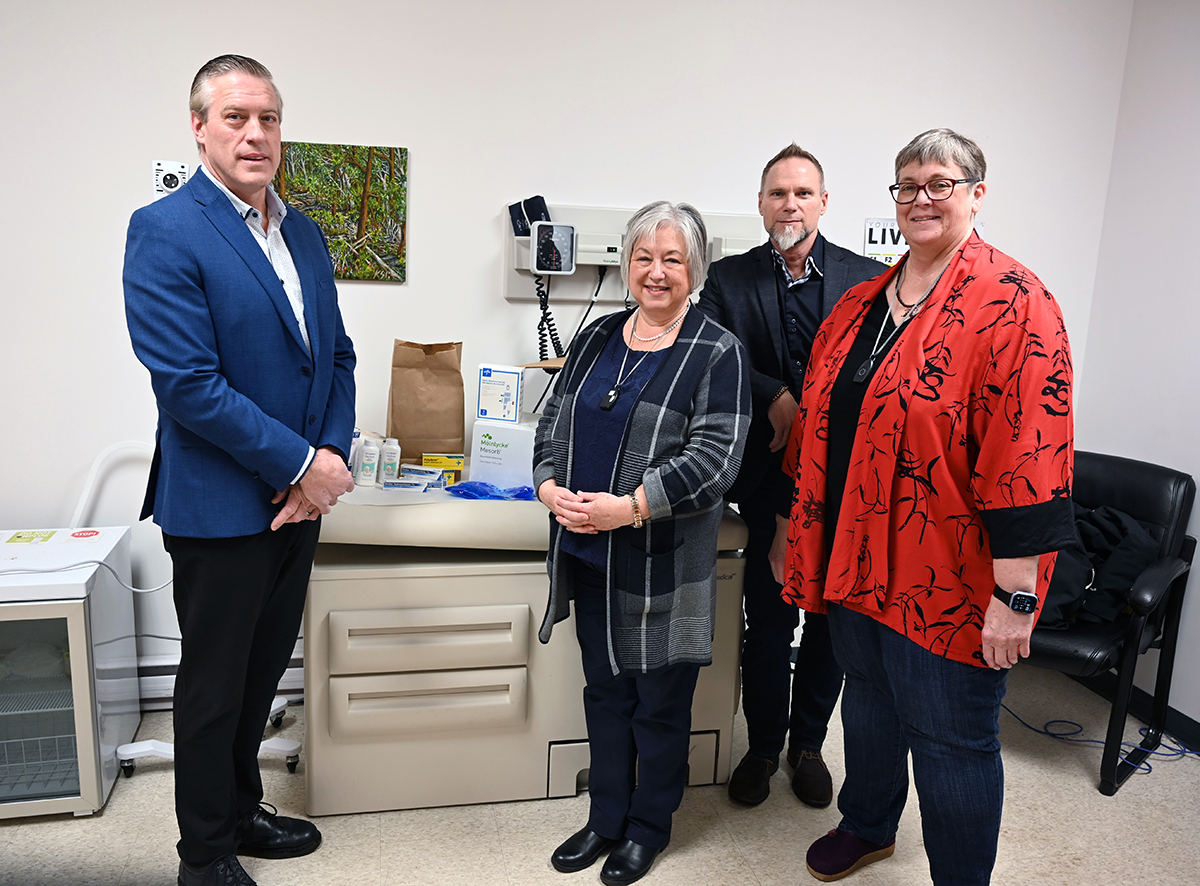
Paul Heinrich, President and CEO of North Bay Regional Health Centre; Keri McGuire-Trahan, Hepatitis C Nurse Practitioner at AIDS Committee of North Bay and Area; Brent Kalinowski, Community Safety and Well Being Planner at the City of North Bay; and Stacey Mayhall, Executive Director at AIDS Committee of North Bay and Area.
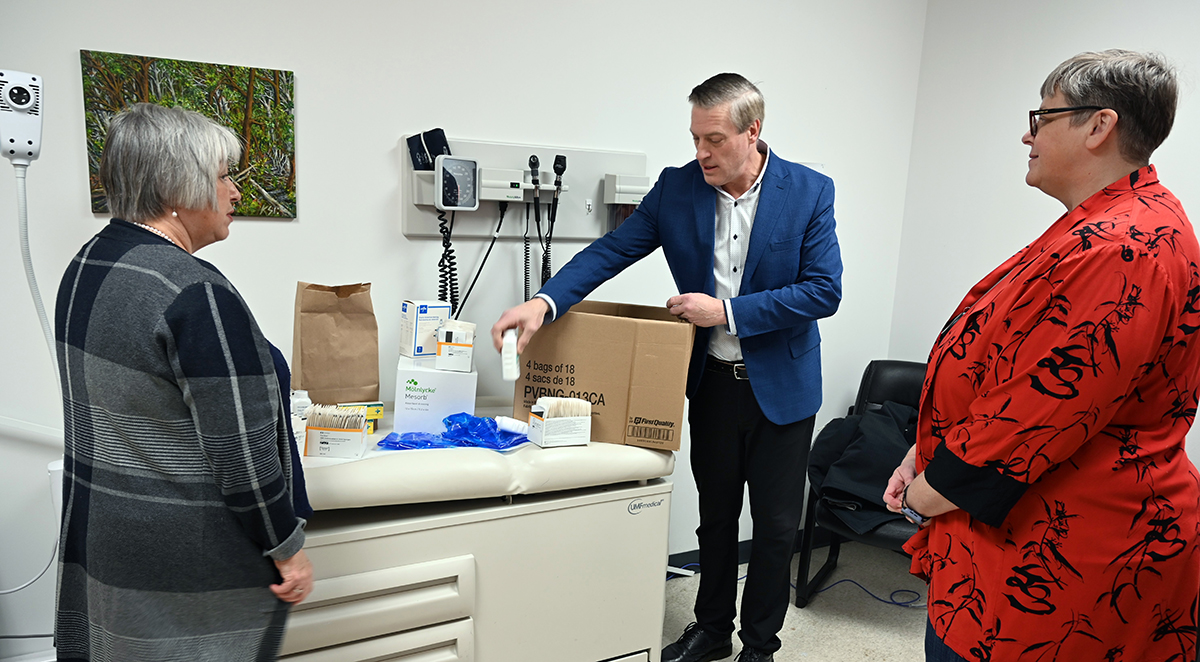
Keri McGuire-Trahan, Hepatitis C Nurse Practitioner at AIDS Committee of North Bay and Area; Paul Heinrich, President and CEO of North Bay Regional Health Centre; and Stacey Mayhall, Executive Director at AIDS Committee of North Bay and Area.
CONCERNED ABOUT WORSENING COLD/FLU SYMPTOMS?
Skip the ED & Visit the NBRHC COVID Assessment Centre for a Physician Assessment
Patients concerned about worsening mild to moderate cold and flu symptoms can now book an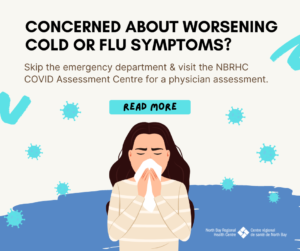 appointment to be assessed by a physician at NBRHC’s COVID Assessment Centre and avoid the Emergency Department.
appointment to be assessed by a physician at NBRHC’s COVID Assessment Centre and avoid the Emergency Department.
The COVID Centre is expanding its scope beyond COVID to help out during the winter respiratory virus flare. The clinic will see children as young as 2 years of age.
The Clinic will allow patients concerned about their respiratory illness to make an appointment to be assessed by a physician instead of waiting in the Emergency Department.
This clinic is for patients with mild to moderate upper & lower respiratory illnesses only and not for other walk-in clinic issues. Patients who are very sick will still need to go the Emergency Department.
The clinic comes as welcome news heading into the busy holiday season, when staffing levels from December 24 – 26th may result in extended waits for less urgent care.
It is also recommended patients review their prescriptions to plan ahead for prescription refills and know what their primary care provider or local walk-in clinic options are before considering the Emergency Department for non-urgent care needs.
The NBRHC COVID Assessment Centre does not accept walk ins due to limited waiting room space. Patients can call 705-474-8600 ext 4110 (select option 1) to book an appointment.
Click here to view a list of the walk-in clinic holiday schedules for the North Bay area.
For many of us, COVID restrictions have lifted and many of us are enjoying life at least semi-back to normal.
It is a different story for health care workers who are still required to wear full personal protective equipment (PPE) during their shifts, screen for COVID-19 daily before work and isolate for 10 days following a COVID-19 exposure.
One area hit particularly hard is the emergency department (ED) at the North Bay Regional Health Centre (NBRHC). Our ED continues to be extremely busy and is seeing higher than average patient volumes, leading to long wait times for some non-urgent care needs.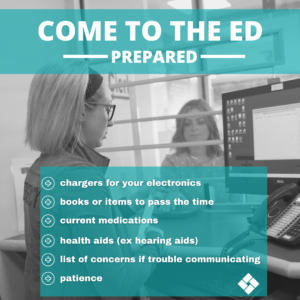
Dr. Lisa Harman, a physician in the Emergency Department, explains these not only have an affect on employee’s physical and mental health, but is also affecting staffing levels across the organization.
“These staff shortages means the physicians, nurses or other health care workers you come across during your visit may be working short staffed and haven’t had a chance to use the bathroom their whole shift,” Dr. Harman says. “Or they may have picked up an extra shift again to help out the department and haven’t seen their families in days.”
The team has been doing an amazing job managing the volume and acuity of the patients we are seeing, but it is a difficult situation for everyone.
The way triage works is the sickest—or most emergent—patients are seen first. “Emergency departments don’t work on a first-come, first-serve basis,” Dr. Harman says. “Patients who come in with an issue that is not urgent will be triaged accordingly. And when volumes are as high as they have been, unfortunately that means wait times for lower acuity care goes up.”
Another factor that increases wait times are the additional safety requirements to protect staff and patients from COVID-19 as the hospital continues to navigate the pandemic. “Keeping the emergency department safe means more time is spent donning and doffing personal protective equipment, and additional time cleaning rooms between patients.”
Understanding that many patients end up at the Emergency Department when other options for primary care (like walk-in clinics) aren’t options, Dr. Harman is encouraging those coming with non-urgent needs to be prepared to wait.
“We know nobody wants to wait for hours in the Emergency Department, and your health care team doesn’t like you to wait either,” she says. “Patients can come prepared with something to pass the time like a book or a charger for their cell phone, any medications they are currently on, health aids like hearing aids and a list of concerns if they have trouble communicating.”
Those patients who do have access to a primary care provider are encouraged to try to be seen if possible, or attend one of the community walk-in clinics.
Patients receiving certain types of surgery at the North Bay Regional Health Centre (NBRHC) can now access a free mobile digital education tool that, together with a dedicated Registered Nurse (RN), will help guide their health care journey and help keep patients on track.
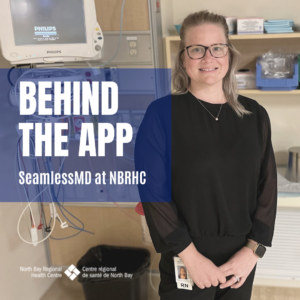
NBRHC has partnered with SeamlessMD to customize the information patients will need to prepare for, and recover from, some procedures at the hospital. The information is accessible either as a mobile app on a smartphone or tablet or online via the website on a computer.
Regardless of how you access SeamlessMD, every patient is supported behind the app by an RN whose role is to help keep patients safe and connected while at home.
At NBRHC that falls to Amanda Gauthier, RN and Patient Monitoring Lead for SeamlessMD. A former emergency and recovery room nurse, Gauthier’s latest assignment has her monitoring patient’s responses and interactions with the app, ready to intervene if necessary.
Patients who have signed up for SeamlessMD have access to health care checks they can do on a daily basis to keep them on track with their recovery. The use of the app by patients is intended to enhance and support existing health care resources—not to replace care. Patients are prompted to provide self-reported data such as pain score, symptoms, range-of-motion, and wound photos, enabling quicker intervention if necessary.
Gauthier explains she is alerted if a patient shares anything via the app that might be out of the ordinary. “When I receive an alert I review the information provided by the patient and if further intervention is required, I call the patient just to make sure everything is ok.” Patients also have access to her extension at the hospital if they need to call her.
The app sends patients reminders about how to prepare for surgery; tips for recovery; to-do lists; and access to a library of information tailored for your surgery. Instead of Googling something you are concerned about, you have trusted information reviewed by NBRHC surgeons and tailored to the surgery experience at our hospital.
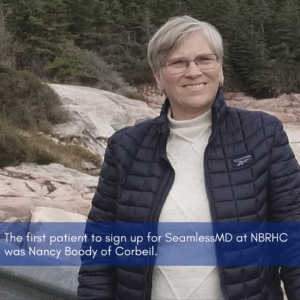 The first patient to sign up for SeamlessMD at NBRHC was Nancy Boody of Corbeil. Boody was scheduled to have a total knee replacement in February at NBRHC and she was approached by Gauthier before her surgery about signing up. “I thought it sounded like a good idea,” says Boody, a retired nurse herself. “In my book, anything that will help and motivate me to get through the post op recovery and rehab was worth it.”
The first patient to sign up for SeamlessMD at NBRHC was Nancy Boody of Corbeil. Boody was scheduled to have a total knee replacement in February at NBRHC and she was approached by Gauthier before her surgery about signing up. “I thought it sounded like a good idea,” says Boody, a retired nurse herself. “In my book, anything that will help and motivate me to get through the post op recovery and rehab was worth it.”
Boody’s surgery was a same day surgery, meaning she was discharged from hospital the same day of her knee replacement. “I didn’t know what it was going to be like,” Boody admits. As she went through her recovery journey at home, she found the app helped motivate her to do the exercises as part of her recovery. “I didn’t want to report that I hadn’t done the exercises I was supposed to,” she says. “It also made me feel more secure knowing there was someone following my progress.”
Gauthier says it is this kind of follow through she finds the most rewarding in her new role. “I’ve never had a role like this, I’ve always been a bedside nurse,” she says. “Most of my career has been short term patient interactions—both in the recovery room and in emergency, you see patients for a very short period of time.” Gauthier says she really enjoys seeing the patients succeed “versus my other roles, when you don’t really know what happened after they leave.”
The technology has been shown to reduce ED visits, hospital length of stay and readmissions. Gauthier says for patients, there really is no disadvantage to sign up for the program. “Patients can use it as much or as little as they want or need.”
Patients who are booked for eligible surgeries at NBRHC will be contacted about signing up for the program. For more information visit the SeamlessMD website at https://seamless.md/ or contact Gauthier at 705.474.866 ext 4422.